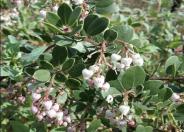
Common name:Fruitless Mulberry, White Mulberry
Botanical name:Morus alba 'Fruitless'
Morus alba 'Fruitless' is a deciduous tree that grows 25' to 50' tall and 35' to 50' wide with glossy green leaves. It's requires low watering (drought tolerant), full sun ( tolerances heat), and will tolerate average to poor soil.

Common name:Big Sur Manzanita
Botanical name:Arctostaphylos edmundsii 'Big Sur'
A knee high sub-shrub manzanita from the Big Sur area of the California coast. Flowers are clear white and a delicate bonus to the dark green, clean foliage, red bark and a nice size. Use as a step down from Sunset manzanita or step up from Arctostaphylos Uva-ursi or mix in patches with Seaside Daisy, Thrift and Encelia californica and Carmel Sur manzanita. This manzanita would also be a stunner in coastal gardens with shore pine or bishop pine as a pine forest retreat. Big Sur manzanita will tolerate beach sand or adobe and with some afternoon shade, can commonly tolerate the SAN JOAQUIN VALLEY (pity the plants, poor souls). Although it is native on the coastal bluffs, this manzanita, along with most other manzanitas, cannot tolerate salt spray very well. If you live next to the coast, remove out of the direct salt spray. Sometimes a boulder or log is enough to protect it, sometimes you'll need the wind shadow of a house. Tolerates full sun in coastal areas and afternoon shade in warm, inland areas. Slowly reaches 3' tall and 4' wide. White flowers bloom in fall and winter. Established plants are drought tolerant. It does best in well draining soil. Attracts bees, birds and hummingbirds. Great for slope stabilization. Deer resistant shrub.

Common name:Big Sur Manzanita
Botanical name:Arctostaphylos edmundsii 'Big Sur'
A knee high sub-shrub manzanita from the Big Sur area of the California coast. Flowers are clear white and a delicate bonus to the dark green, clean foliage, red bark and a nice size. Use as a step down from Sunset manzanita or step up from Arctostaphylos Uva-ursi or mix in patches with Seaside Daisy, Thrift and Encelia californica and Carmel Sur manzanita. This manzanita would also be a stunner in coastal gardens with shore pine or bishop pine as a pine forest retreat. Big Sur manzanita will tolerate beach sand or adobe and with some afternoon shade, can commonly tolerate the SAN JOAQUIN VALLEY (pity the plants, poor souls). Although it is native on the coastal bluffs, this manzanita, along with most other manzanitas, cannot tolerate salt spray very well. If you live next to the coast, remove out of the direct salt spray. Sometimes a boulder or log is enough to protect it, sometimes you'll need the wind shadow of a house. Tolerates full sun in coastal areas and afternoon shade in warm, inland areas. Slowly reaches 3' tall and 4' wide. White flowers bloom in fall and winter. Established plants are drought tolerant. It does best in well draining soil. Attracts bees, birds and hummingbirds. Great for slope stabilization. Deer resistant shrub.

Common name:California Honeysuckle
Botanical name:Lonicera hispidula
California honeysuckle is a climbing deciduous shrub/vine with beautiful pink flowers. It is native throughout much of California and up into Washington. California honeysuckle can handle full sun to shade. It's drought tolerant. Use as a bank filler or groundcover. It has an edible berry but bitter. It seems to be deer proof. Hummingbird flower. It is hardy to about -10 to -15 degrees F. Its red berries are relished by the birds. Flowers yellowish at base, pinkish, in upper portion, grows in oak woodland, good in clay soil.
Designer: Homeowner
Photographer: Vicki Anderson
Maintain a two to four inch layer of mulch on the soil surface to reduce weeds, infiltrate rain water, and reduce compaction.
Develop healthy soil for plants that are vigorous and naturally pest-resistant.